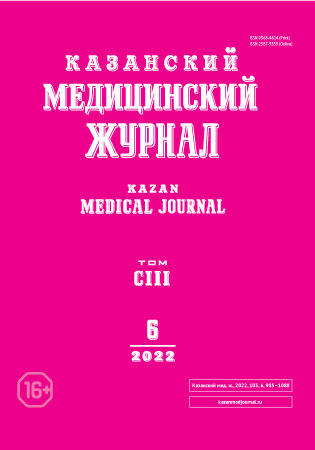Comparative assessment of the quality of life and the effectiveness of treatment in patients after early and delayed anterior cruciate ligament reconstruction
- Authors: Radysh I.I.1
-
Affiliations:
- Clinical Hospital No. 1 of Russian Federation President Administration
- Issue: Vol 103, No 6 (2022)
- Pages: 955-961
- Section: Theoretical and clinical medicine
- Submitted: 09.06.2021
- Accepted: 02.09.2022
- Published: 02.12.2022
- URL: https://kazanmedjournal.ru/kazanmedj/article/view/71412
- DOI: https://doi.org/10.17816/KMJ71412
- ID: 71412
Cite item
Abstract
Background. In modern medical practice, a significant interest in the study of quality of life is manifested in the biopsychosocial approach, which indicates the concept of a holistic view of the course of the disease and the effectiveness of treatment.
Aim. To give a comparative assessment of the quality of life and the effectiveness of treatment of patients after early and delayed reconstruction of an isolated injury of the anterior cruciate ligament.
Material and methods. The results of a survey of 782 patients aged 18–54 years according to the international standardized questionnaire of the quality of life (SF-36 — Short Form-36 Health Survey Questionnaire) before and after arthroscopic reconstruction of an isolated injury of the anterior cruciate ligament using a free autograft from the tendons of the semitendinosus and tender muscles are presented. All patients were divided into two groups. The first group included 403 patients (232 males and 171 females), anterior cruciate ligament plasty was performed at an early stage, from the 1st to the 6th week after the injury. The second group included 379 patients (211 males and 168 females) who were operated on late, from the 7th week to 1 year after the injury. Statistical analysis was performed using the Statistica 12.0 program (Stat Soft, Inc.). The significance of differences between independent samples was determined using nonparametric tests: the Mann–Whitney U test and the Wilcoxon T test.
Results. It was found that 1 year after the operation, in patients of the first group, the values of the treatment effectiveness indicator in terms of the total indicator of physical and mental components of health are significantly higher compared to the second group (p <0.0001, Mann–Whitney U-test). A high correlation between the indicators of treatment effectiveness according to the assessment scales of the physical component of health and the mental component of health in groups depending on the timing of the reconstruction of the anterior cruciate ligament was found. Thus, the Spearman's rank correlation coefficient in the first group between the indicators of treatment effectiveness in terms of the total indicator of the physical and mental components of health was r=0.79 (p=0.001), and in the second group — r=0.71 (p=0.001).
Conclusion. The long-term results of assessing the quality of life of patients indicate the predominant effectiveness of the treatment of patients operated on in the early stages after injury, compared with delayed surgery.
Full Text
About the authors
Ivan I. Radysh
Clinical Hospital No. 1 of Russian Federation President Administration
Author for correspondence.
Email: dr-ivo@yandex.ru
ORCID iD: 0000-0002-1585-5402
M.D., Head of Depart., Depart. of Traumatology, Orthopedics and Medical Rehabilitation
Russian Federation, Moscow, RussiaReferences
- Spronk I, Geraerds AJLM, Bonsel GJ, de Jongh MAC, Polinder S, Haagsma JA. Correspondence of directly reported and recalled health-related quality of life in a large heterogeneous sample of trauma patients. Qual Life Res. 2019;28(11):3005–3013. doi: 10.1007/s11136-019-02256-z.
- Perelman NL. History and methodological basics of quality of life conceptions. Bulletin physiology and pathology of respiration. 2019;(72):112–119. (In Russ.) doi: 10.12737/article_5d0ad216a56793.64561711.
- Usmanova EB, Shchelkova OYu, Isurina GL, Sushentsov EA, Valiev AK, Sofronov DI. Quality of life questionnaire for patients with oncoorthopedic disease. Counseling Psychology and Psychotherapy. 2019;27(2):147–166. (In Russ.) doi: 10.17759/cpp.2019270210.
- The WHOQOL Group. Development of the World Health Organization WHOQOL-Bref. Quality of life Assesment. Phys Med. 1998;28:551–558. doi: 10.1017/S0033291798006667.
- Martinec R, Pinjatela R, Balen D. Quality of life in patients with rheumatoid arthritis — a preliminary study. Acta Clin Croat. 2019;58(1): 57–166. doi: 10.20471/acc.2019.58.01.20.
- Filbay SR, Pandya T, Thomas B, McKay C, Adams J, Arden N. Quality of life and life satisfaction in former athletes: A systematic review and meta-analysis. Sports Med. 2019;49:1723–1738. doi: 10.1007/s40279-019-01163-0.
- Radysh II. Gender differences of the quality of life before and after anterior cruciate ligament arthroscopic reconstruction. Tekhnologii zhivykh sistem. 2019;16(1):21–28. (In Russ.)
- Khominets VV, Rikun OV, Fedorov RA, Abramov GG, Gamolin SV, Grankin AS, Fedotov AO. An importance of early diagnosis in the course of knee joint instability treatment in military personnel. Voenno-meditsinskiy zhurnal. 2015;(3):26–31. (In Russ.)
- Filbay SR. Early ACL reconstruction is required to prevent additional knee injury: A misconception not supported by high-quality evidence. Br J Sports Med. 2019;53(8):459–461. doi: 10.1136/bjsports-2018-099842.
- Murray MM, Kalish LA, Fleming BC, Flutie B, Freiberger C, Henderson RN, Perrone GS, Thurber LG, Proffen BL, Ecklund K, Kramer DE, Yen YM, Micheli LJ. Bridge-enhanced anterior cruciate ligament repair: Two-year results of a first-in-human study. Orthop J Sports Med. 2019;22;7(3):2325967118824356. doi: 10.1177/2325967118824356.
- Von Essen Ch, Eriksson K, Barenius B. Acute ACL reconstruction shows superior clinical results and can be performed safely without an increased risk of developing arthrofbrosis. Knee Surg Sports Traumatol Arthrosc. 2020;28(7):2036–2043. doi: 10.1007/s00167-019-05722-w.
- Ware JE, Kosinski M, Grandek B. SF-36 Health Survey: manuаl and interpretation guide. Lincoln, RI: Quality Metric; 2005. 316 p.
- Fernandes CSE, Lima MG, Barros MBA. Emotional problems and health-related quality of life: Population-based study. Qual Life Res. 2019;28(11):3037–3046. doi: 10.1007/s11136-019-02230-9.
- Tisherman R, Meredith S, Vaudreuil N, de Sa D, Musahl V. Instability following ACL rupture: What do we need to restore during reconstruction. Dtsch Z Sportmed. 2019;70:31–37. doi: 10.5960/dzsm.2018.360.
- Buckthorpe M, La Rosa G, Villa FD. Restoring knee extensor strength after anterior cruciate ligament reconstruction: a clinical commentary. Int J Sports Phys. Ther. 2019;14(1):159–172. doi: 10.26603/ijspt20190159.
Supplementary files








